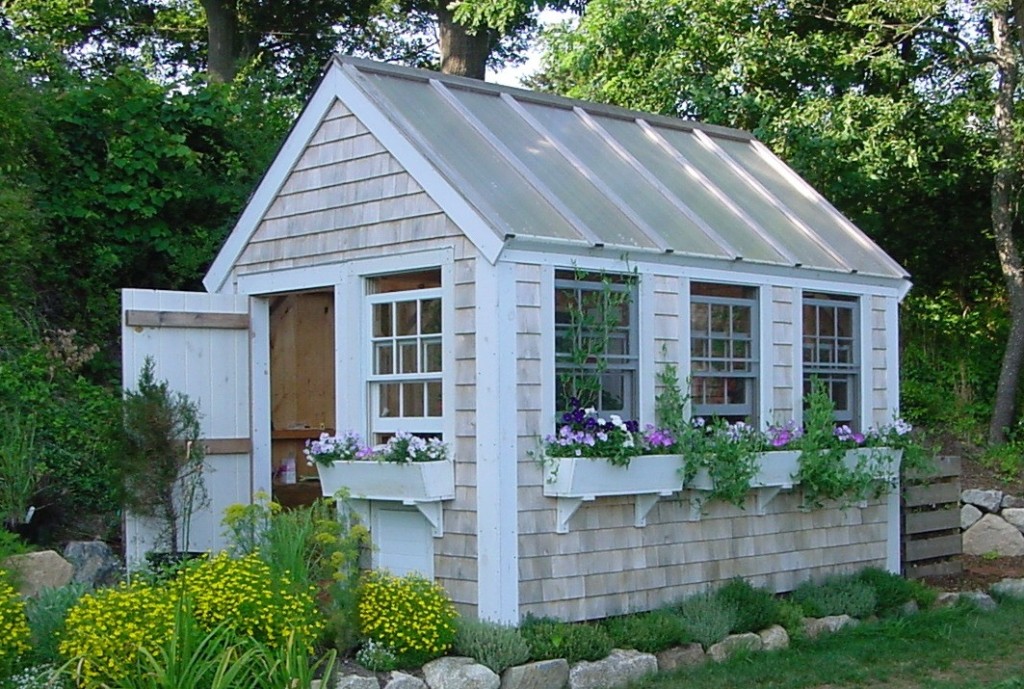You can use some DIY storage shed plans to build a backyard shed in a few weekends. But many things can go wrong.
If you are crafting a shed for the first time, you will likely make some mistakes. Here are the common blunders that most amateur shed builders make during construction.
Forgetting To Run Electricity To The Shed

source: familyhandyman.com
You may end up building a lovely shed kits diy, but if you forget to install electricity, then it will greatly limit its use.
You will need to have some electric light inside the shed if you want to use it at nighttime. Even during the day, some corners may still be dark.
One light should also be installed above the entrance to the shed so that you can clearly see the path as you move in and out of the building.
If you end up spending more time inside your shed than expected, then it may also be useful to install a few wall sockets that can be used to power electrical gadgets.
Ignoring Future Shed Uses
You may feel that right now, all you need is a 10×10 shed, and that may be correct. But have you considered how your needs may change a few years from now?
Your shed may soon get filled up with stuff and cause you to run out of storage space. Before you finalize the size you need, think of all possible uses you may have for the shed in the future.
Think about the size and quantity of equipment that you may require to store in the future. You may even want to use the building as a spare office or gym and not just a storage space.
Take time to think about your future space needs before you decide on the dimensions needed for your shed.
Neglecting To Add Overhangs And Gutters

source: entegra.com.au
Water and snow are a shed’s enemies. You need to keep them as away from your structure as possible.
If your roof doesn’t overhang far enough from the walls, then rain or thawed snow can end up dripping on your shed walls and damage them over time.
Extend the rafters at least a foot away from the walls to ensure adequate shelter for the walls. Also, install a gutter along the drip edge to channel the water safely away without spillage.
Not Installing Ventilation Fixtures
Every shed must have some ventilation ports. If you store any kind of valuable equipment in your shed, there needs to be a steady airflow.
Stale air stimulates the growth of mold, which can damage your gear. Also, paints and varnishes stored in the shed will give off fumes that can accumulate over time and cause a fire hazard.
Even if you have built large windows into your building, it is unlikely you will keep them open always. So, install gable vents or a cupola in the roof to allow for ample ventilation inside your shed.
Unsuitable Shed Position

source: homeadvisorhomesource.com
Not every corner of your garden or backyard is suitable for locating your shed.
There must be at least a one-foot clear space around your shed without any boulders, trees, or fences. The entrance to the shed must have at least 3 feet of clearing in front to allow for easy movement.
Your shed should also be located on land that is almost perfectly flat. If there is any slope in the ground, then it must be corrected with a gravel pad before you craft the foundation.
Your backyard may also have underground utility lines. Make sure to call the company and find out the exact line locations before you start digging for the foundation. The shed should not be located over a gas or water line.
Every local building council usually maintains its own set of regulations about how far a shed needs to be located from the property line and the main house. Check with your building council and find out about these rules before you begin construction.
Untreated Wood Used In Floor Framing
All the shed components that are close to the ground, like skids, joists, posts, and stringers, should only be crafted from pressure-treated wood.
It is also recommended to use weather-proof siding on the walls.
Lumber that is untreated will quickly absorb moisture from the ground and start swelling. It will also get infected with insects and molds. This will cause the shed foundation to become unstable and require frequent repairs.
It would be best if you could use weather-proof lumber for the entire shed. But if that is too costly, then at least the floor framing members need to be made out of water-resistant timber.
Not Enough Details In Shed Blueprints

source: familyhandyman.com
Starting with the right shed blueprints is essential if you want to avoid costly corrections later on.
Your shed plans should show the elevations from all sides and details of the floor frame, wall frame, and roof frame.
Accurate dimensions of each framing member must be clearly shown as well as the angle of the cuts that need to be made. The plans should also provide a complete cutting list.
Many free plans on the internet don’t provide much of the details needed for building a shed without any guesswork.
If you jump right into construction before you have all the necessary details, it can cause you a lot of headaches later.
Make sure to only start on the project after you have the details for every shed component and a clear understanding of how it fits with the other components.
Keeping these tips in mind will ensure your shed building project completes smoothly and within budget.



